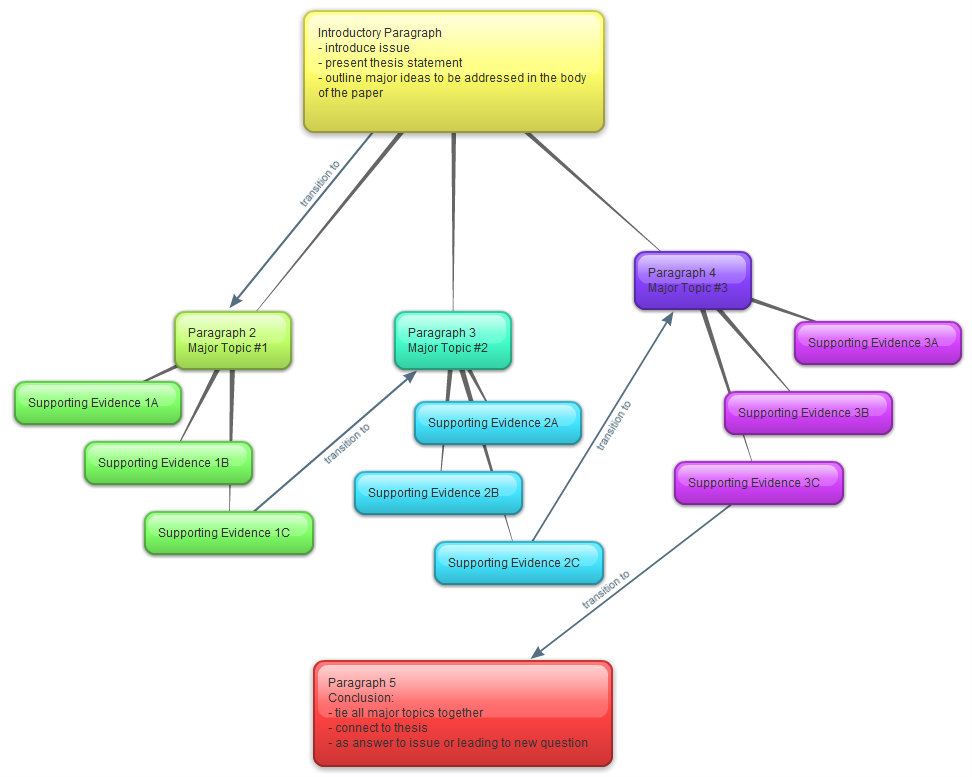|

Click here for a visual diagram of a paper outline
Some brief "how to"
videos:
- Identify a topic of suitable focus for the given length
of your paper. Your topic should not be so broad
that you cannot do it justice in the allotted word count. Your topic
should also not be so specific that you need to "pad" your
paper to reach the allotted word count, or don't reach it at all.
- Develop a thesis statement - a point you intend to
make. This sentence usually appears at the end of
your introductory paragraph. A thesis is a theory, hypothesis, or
interpretation of your chosen topic that your paper will explore and
argue for using supporting evidence, drawing logical conclusions, based
on well structured arguments. A good paper does more than simply present
information - it does something with that information!
- Compose an introductory paragraph that
opens with a "hook" to grab your reader's attention, interest,
and/or curiosity. Your introduction should then move on to briefly
introduce the topic, placing it into an appropriate context (e.g.,
historical, social, etc.). You should also outline major issues of
concern that will be addressed at some length in the body of your paper
regarding the topic. Conclude your introduction with your thesis
statement.
- Compose a suitable number of body paragraphs exploring
your topic in some depth and supporting your thesis. Each paragraph
should be focused around a topic sentence - the major point discussed in
the paragraph. This major point should be supported and further explored
through use of examples or other suitable minor points, all related to
the major point. Additional major points should be presented as new
paragraphs - one major point per paragraph!
Use
the PEE paragraph structure:
-
P
= the main topic or point
of the paragraph (your topic sentence) should relate to the paper
thesis and appear as the first sentence of the paragraph
-
E
= provide sufficient evidence
(examples, quotes, paraphrases and other arguments) from the reading
or other sources to support the main point of the paragraph
video:
How to write a
good paragraph
- Although you are arguing for your position (your
thesis), do not neglect to consider alternative perspectives. You
may incorporate these to some degree, in modified form, or reject them
as unsatisfactory. But be sure to give supporting reasons for rejecting
alternative theories, just as you give reasons for supporting your own
theory. By presenting opposing arguments, you make a stronger case for
your own argument, anticipating and addressing doubts your reader may
have regarding your own argument.
- Compose a concluding paragraph
which reminds your reader of your thesis, briefly sums up your
conclusions, suggests the possible ramifications of these conclusions,
and leaves your reader with a powerful impression and something to
ponder.
- Consider composition: be sure to
use transition statements and provide a logical progression of ideas
from paragraph to paragraph. This provides for flow from one paragraph
to another, creating a cohesive paper. Spelling, grammar, and syntax
(sentence structure) should be suitably sophisticated for college level
writing. However, do try to avoid awkward run-on sentences and sentence
fragments.
- Consider using a variety of rhetorical strategies.
Here are some suggestions.
- Avoid plagiarism - be sure to properly cite sources for
any quoted or paraphrased material (using foot-, end-, or parenthetical
notes). Also include a complete and proper list of references
("works cited") at the end
of your paper. APA
or MLA guidelines are recommended for
citations (MLA
citation video). For more information
regarding plagiarism and how to avoid it, check out this
site.
|